By Tom McHale
This is a list of things I like to check out when I have my AR 15 rifle field stripped for basic AR-15 Maintenance & cleaning.
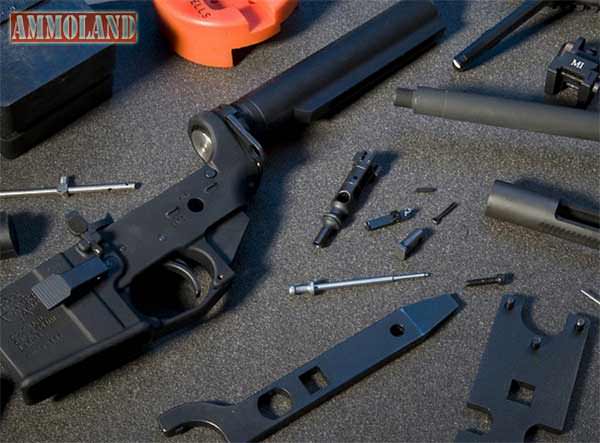

USA –-(Ammoland.com)- Cleaning your AR-type rifle is a great opportunity to run through a quick checklist of preventative maintenance and inspection steps.
Investing a few seconds in some quick checks may just help your rifle from vomiting parts while at the range, which can ruin your fun range day and embarrass you in front of your friends.
If you kick in doors for a living, you (hopefully) already have a personal routine for rifle maintenance – it’s life and death after all.
But if you’re a recreational or competitive shooter, then you can afford to be slightly less rigorous. Contrary to internet myth, the AR platform has become a pretty darn reliable piece of equipment.
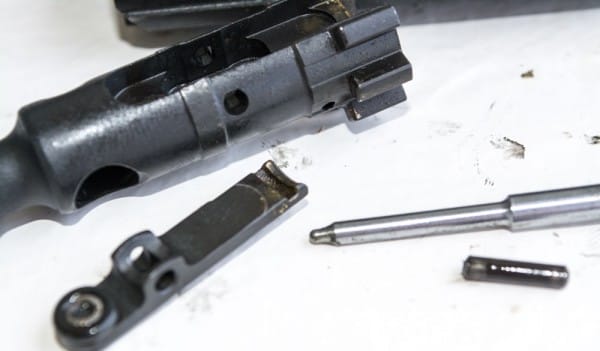
Back to the point. I jotted down this list of things I like to check out when I have my rifle field stripped for basic cleaning. Take a look, but don’t get all stressed out about every little detail. Your AR-type rifle is a remarkably resilient platform.
We’ll be using a Smith & Wesson M&P15 OR (Optics Ready) rifle as our model for this exercise. It’s a common gun that’s solid and reliable, with standard parts.
1. AR-15 Takedown Pins
You can check the very first item as you separate the upper and lower halves of your rifle. If everything is fit properly, you should be able to push the takedown pins through with hand pressure or very light tap. If you have to break out a hammer to move your takedown pins, something is wrong – the whole point of the AR design is to be able to use a finger, bullet tip or field-expedient tool, like the Real Avid Ar15 Tool, to field strip the rifle for basic maintenance.
Besides, hammering away on your (most likely) aluminum receiver is usually detrimental to the long-term health of your gun.
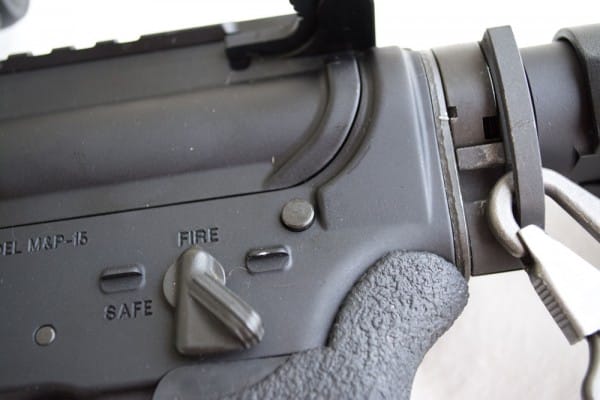
2. AR-15 Muzzle Devices

While we’re still on the outside, give your muzzle device (brake, flash hider or silencer) a firm twist in both directions. Is it solid? While rare for a factory mounted device to work loose, it happens.
If you’ve ever removed the factory muzzle device and put your own in place, it’s somewhat more likely.
A half-second check, every cleaning, can prevent a whole lot of embarrassment and worse yet, flying chunks of metal.
3. AR-15 Optic and Mount
Another no brainer is your optic and mount. Check the bases to make sure they’re still tightly affixed to the receiver. Check the scope rings, if applicable to make sure they’re tight to the proper specification. Poor accuracy from a rifle is almost always the result of something silly like a bad scope or scope loose mounts. Sometimes its optic internals and you can narrow that down by ensuring that the externals are solid.

4. AR-15 Bolt Carrier Gas Key
When you open the upper receiver, the first thing you do is remove the charging handle and bolt carrier group. Since you’ve got your hand on it anyway, this is a great time to do a quick visual and tactile inspection of your bolt carrier gas key. Look at it to make sure the screws are firmly in place. More importantly, give it a firm twist with your hands. It should be rock solid on the carrier body itself. If it’s not, you’re going to have some malfunctions headed your way as gas is bleeding off before doing it’s thing. The repair procedure is too involved to cover here, just know you’re going to want to take it completely apart, thoroughly clean and degrease everything and firmly remount it and stake the screws in place.

5. AR-15 Bolt Carrier Body
As you disassemble the bolt from the carrier, check the carrier body itself for cracks. Pay close attention to high-impact areas like the cam pin hole – that takes a beating over time. If you see any cracks in your carrier, it needs to be replaced. No big worries though, for a recreational rifle, this is somewhat unlikely unless your bolt carrier group is made out of Mighty Putty.
6. AR-15 Maintenance – Bolt Lugs
This is also a good time to inspect the lugs on your bolt. Make sure there are no chips or peening signs. Peening is just a fancy word for “smashed” or “dented.” If you see signs of either, it’s time for a new Ar15 bolt.

7. AR-15 Maintenance – Firing Pin
When you wipe down the firing pin, put on your Mr. Magoo specs and look at the tip. It should be smooth and rounded – no chips or weird dents. Again, if you see either, get a new one. They’re cheap.
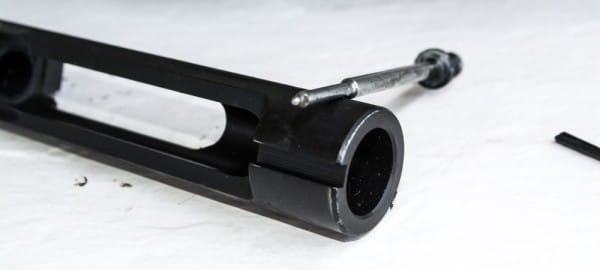
8. AR-15 Maintenance – Extractor and Spring
I like to pop off the extractor and take a quick look since that’s one of the more likely failure points. Check the extractor to make sure it’s whole and has nice sharp edges. Also take a look at the spring and booster. That’s a plastic insert inside the spring. Again, these are all cheap parts, so if anything is missing or looks wonky, replace it.
9.AR-15 Maintenance – Gas Rings, or Not
People get all lathered up about gas rings. If they’re not perfectly “unaligned,” meaning none of the gaps line up, then the moon might crash into Possum Kingdom, South Carolina. And that would be tragic indeed. In reality, If you have more than one gas ring in place, your rifle will most likely still function – gaps aligned or unaligned. If memory serves, AR guru Patrick Sweeney did some tests way back when to test this and found that it just doesn’t matter all that much. Once again, if you’re employed as one of those dudes or dudettes that line up outside Meth labs or clay huts, then you might pay more attention. As to the rest of us? Check them and tweak their orientation, but don’t lose a lot of sleep over the issue.
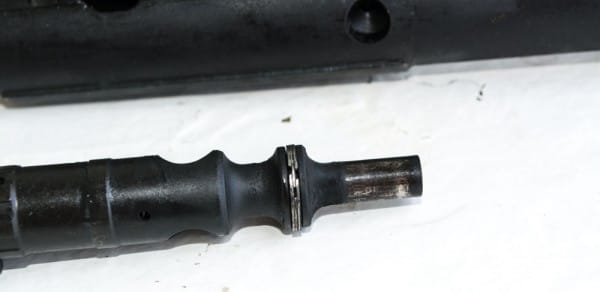
In an ideal world, what you should see is three normal looking gas rings, with the gaps unaligned. To test for wear, simply pull the bolt out of the carrier as far as it will go. Stand the bolt and carrier up on a flat surface. If the carrier doesn’t start to slip down, you’re good to go. If it does, your gas rings are worn. Get some new ones.
10. AR-15 Maintenance – Lower Receiver
Moving to the lower receiver, take a peek down into the trigger assembly area. You’ll almost certainly see grime and crud, and that’s OK – you’re about to clean it after all. What you don’t want to see are primers or pieces of primers. If primers are getting blown out of cartridges once in a while, that could be indicating pressure problems with your ammunition, overheating or possibly headspace problems.
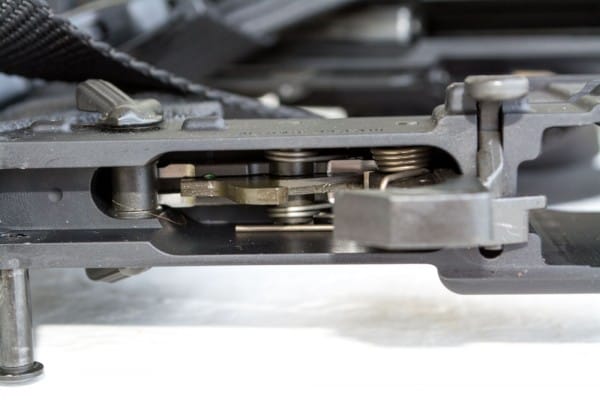
11. AR-15 Maintenance – Recoil Buffer and Spring
Remove your AR15’s buffer and spring. Check for gunk in the buffer tube and wipe it out as necessary. While you have the parts out, check the buffer itself to make sure it’s smooth and not messed up. Give that spring a wipe too. If you’re a casual or recreational shooter, you can lube up the spring to quiet some of that “sproing” noise during recoil.
Sproing is another fancy word, but fortunately it does not cause harmful things like peening – it just sounds uncool.
12. AR-15 Maintenance – Magazines
You might as well pop the bottom off your magazines and give the interiors a quick inspection and wipe down. If you’re dropping them in the dirt, they will get crud in them. One of the biggest causes of malfunctions is dirty and / or damaged magazines and it’s easy to be proactive about that. If I’m having reliability issues, the magazines are the first thing I’m going to check.
13. AR-15 Maintenance – the Cool & Fun Factor
Last on the list, after you reassemble the upper and lower receivers, take a good look at your rifle as a whole. Is it still awesome? Does it still look ridiculously handy and fun to shoot? Yes? Then you’re good to go!
How about you? How rigorous are you with preventative maintenance? What are the things you look for?
EXTRA VIDEO : AR-15 Maintenance : Field-strip, Clean and Lubricate an AR-15 – Gunsite Academy Firearms Training
Tom McHale is the author of the Insanely Practical Guides book series that guides new and experienced shooters alike in a fun, approachable, and practical way. His books are available in print and eBook format on Amazon. You can also find him on Google+, Facebook, Twitter and Pinterest.



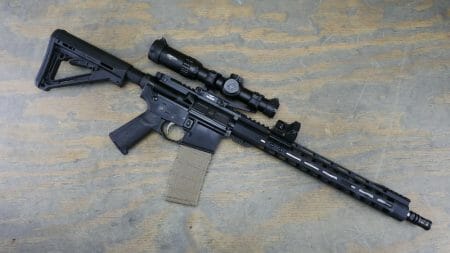
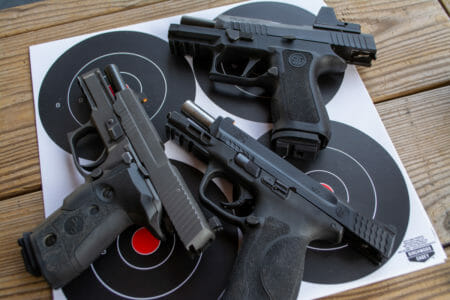
Why does the ejected cartridge have a crimp in the discharge end after firing and ejecting on my AR?
I don’t know why yours does that but on my rifle I have determined the shell is striking the housing area of the forward assist .
Humping 22 / 20 round mags w/19 rds in each is why an AR in 5.56 is acceptable in combat!
And, on a 5 or 6 day ‘search and destroy’ operation when also carrying 4 frags, 2 smoke, a claymore, a prc25 and spare battery, C-rations, (prior to freeze dry which increased water usage), along with said water, and food, skeeter/insect repellent, and other personal needs. Resupply was not a promise written in stone.
Then there’s the environment…!.
Whoa whoa there 2nd Amender…. What is this crazy crap you’re talkin’? You mean to tell me war-fighters had to operate beyond a Starbucks parking lot? But with all that other gear, where is one to put all their Morale patches and tacticool bracelets?
I think you’re just being melodramatic.
(Now where did I put my “How to Shoot with Iron Sights” pamphlet?)
Never cared for AR platform from early 70’s in BCIT nor since. Shoulda stuck with the M14 , a carbine on that platform a much better choice. Accuracy, durability, knock down power, easier to maintain & battle rifle & long range rifle with many options. So nuff said. Now gotta throw lotsa lead real fast & get outa there ASAP. BUT NOBODY hears the grunt, we’re expendable & “cheap” is good. Why do we keep going back to a good.30 cal wpn? Go figure!!!
CURIOUS? NO MENTION OF OILS. AN AR *MUST* STAY SLIGHTLY WET TO PERFORM in tough environments – U KNOW – LIKE UR WIFE (ewwwww! now thats really gross!). I use the NRA-ENDORSED ‘SLIP2000 EWL’ exclusively -on ALL my weapons, actually. And dont fear Desert HEAT or Frigid TUNDRA COLD, nor Salt water or rain… NOW: If u stay at the Range, primarily… really dont matter WHICH SUPER SYNTHETIC u use… many good ones… even FROGLUBE. Just make sure its a “SUPERSYNTHETIC” – not REM OIL or something. Save THAT 4 ur home Doors… [Got MOBILE ONE? actually – and INCREDIBLE… Read more »
Actually, Mobil 1 or any 100% syn 10w30 oil works great in all environments, especially on full auto.
Additional things that i check: Is the castle nut tight. With the extractor in the bolt, can you press down on the tail end of the extractor and it moves easily ? If so, replace the extractor spring with a stronger extractor spring. I use a knife sharpening stone to take some of the point off of the take down pin detents. Just a little bit. I use just a little bit of oil on the BCG where it contacts the upper receiver. Also a couple drops in the cam pin area. The BCG glides smoothly inside the upper receiver… Read more »
Don’t forget to inspect the cam pin, they can crack or break after so many rounds.
To Dave T and Douglas who. You two morons don’t even deserve a return comment. The reason AR. type fire arms are so popular is morons like you can put one together.Bill
Shortcomings of the standard AR: The 5.56/.223 cartridge isn’t as powerful as the AK’s 7.62X39. However, quality accurate 5.56/.223 is less expensive and easier to come by than quality and accurate 7.62X39 that is still less accurate than 5.56/.223. Shortcomings of the standard AR: There’s so many options from quality companies you can choose or add-on to the AR that it can be confusing. The AK has it easy, you’ve got CAA and Crapco…I mean Tapco. Shortcomings of the AR: Pretty much every part is held in place by a screw or a pushpin, very few rivets, making it too… Read more »
There are a lot of AK variants out there. Read the range report from the guy who runs a large operation in, I believe, Nevada. Hundreds of thousands of rounds through all types of guns; AR’s, AK’s, you name it, semi and full. He found that AK’s fail and don’t hold up any better than DI AR’s. The key is maintaining both. That said they all break.
And the problem with trying to have civilized conversations is there are always people like you who jump in and, instead of offering a reasoned opinion, start calling people names and denigrating them simply because they disagree. On the plus side most of realize this is the last resort of a person with absolutely nothing substantive to contribute.
Never mentioned round count between cleanings. Do you clean your AR every time you shoot it ? How often,box of 20 rounds or after a 100 round NRA match ? Or after a 3 gun or Tactical match say a few hundred.People have been known to wear out the accuracy of barrels by cleaning too often,happens with .22’s. So keep a small notebook in your gun bag with info on that gun,total round count,last cleaning,come-ups for ammo used. Clean after each match,or similar round count. Use the pull through ropes after all use,easy & quick.BTW,there is a lot to like… Read more »
I can’t stand that “crap where they eat” nonsense. The design is nearly 60 years old. If it sucked so bad, it would have fallen by the wayside years ago.
I don’t understand why these helpful articles always seem to draw haters . But if I shot more than a few hundred rounds a year the other advise would be attractive .
Head Space, Bore Erosion, Firing Pin Protrusion, Barrel Staightness and Firing Pin Hole Gauges:) Advice from an Armorer.
Why should someone buy something that you have to check and work on every time you want to fire it. Buy a SKS or a AK 47 no problem. Buy a L1A1 or a Cetme no problem
——————————————————————————————
The simple answer Bill is that many of us do not see doing routine maintenance to our firearms as “having to work on them” we simply want to take care of a piece of equipment that are very lives may depend on someday, something we all should do regardless of the style of firearm or the brand.
Very well put Dave, that goes with any and all tools weather they go bang or are tradesmen tools!
This question has nothing to do cleaning and care of your AR. This question about its function , the buffer. First, I’m new to the AR. The buffer weight, most entry level AR come with buffer weighing in @2.9 pounds. Ejecting cases @ 1-2 o’clock, is this ok or it really does matter as long as the cases leave the rifle. So what the true on this? My AR gas block about 9″ with a 16″ bbl 1/7 twist with a hand guard 15″.
It all has to do with balance. Different buffer weights and spring compression ratios work better for different loadings within certain grain-age of bullets and powder. If you are a re-loader, you might want a heavier or lighter buffer and/or spring to compensate for the style of bullet or amount of powder that you use. Most manufactured, as opposed to home built ARs are going to come with a buffer and spring that is designed to be reliable with factory loaded bullets within a certain grain range. For example, my factory built Colt AR is good for up to, 75… Read more »
I live in Goose Creek, that is well within Possum Kingdom, South Carolina. and I truly do fear the moon crashing here. I would prefer it (as most people would) to crash on COWlifornistan or New Yoik.
I would like to see that happen too in the places you mentioned. But there is one hell of a lot of really good people in NY,KALI.,ECT. too. Only after they have left and socialist scum are the only ones left have the moon come down,and come down hard !
Thank you Tex!
Tex is a prejudiced bastid! The only reason he wants to postpone destruction of those areas is because he’s still running shine there and doesn’t want to lose the revenue stream. Oops, forgot I wasn’t supposed to say that. Sorry Tex.
Why should someone buy something that you have to check and work on every time you want to fire it. Buy a SKS or a AK 47 no problem. Buy a L1A1 or a Cetme no problem .
Enjoy your eyes and digits while you still have them.
“Prof”. Spurgeon gave us the $64,000 answer…’Quit messin’ with them AR’s and purchase a SKS or an AK-47/74, AR platform(s) have too many moving parts and are one big Excedrin headache…Ask any former GI that served very early in the Viet Nam conflict on the front lines and they will agree with the Professor & myself… I remembered those ‘lessons’ back in 61′ and quickly learned to pick up Charlie’s ‘dropped’ SKS or AK and ammo and continue pulling the trigger…SKS & AK’s are excellent examples of the KISS Principle…
Considering the M16 want used in Vietnam until 1964, something doesn’t add up. ?
Just a real quick mention that things have changed a lot in AR land since the 60’s. That aside, we shoot what we enjoy. I have all of the aforementioned rifles, believe my FAL is one of the finest rifles ever made but also love my AR’s. Yup, plural, 5.56, 6.8 & 300. Love ’em all.
In the early years of the Viet Nam war the ammunition was the primary culprit.
The powder used was the wrong type for the humid conditions and resulted in many malfunctions, as it was prone to pick up moisture. The powder was ball type and when replaced with the stick powder many of the malfunctions ceased.
Safety first gentlemen! Remove the mag and check the chamber before starting any of this work.
That is advisable advice !
Barrel Bore…check for rust, worn lands, damaged lugs/feed lips, etc. Also check front sight base for signs of gas leaks (powder residue where sigh base attaches to barrel), and that the front sight base is still tight on the barrel… won’t wiggle around.
Douglas,
I just remembered why I rarely respond to forms, it seems there is always some angry person who hides behind the anonymity of the web to further their cause for whatever is their favorite truck, firearm, shovel, city or ??? because their view is the only correct one, what always astounds me is people who so vehemently dislike something spend precious time to read up on it and then spew their thoughts of disgust for that topic. Oh well from one Moron to another have a great day.
Dave